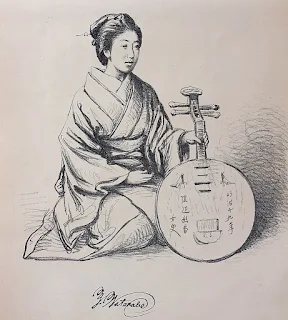These two postcards offer rare and compelling insights into the network of Japanese artists during the Meiji period, subtly “knitting together” personal and professional relationships that have otherwise gone undocumented.
Yamana Ukai, April 17, 1889
Postmarked in Shitaya, Tokyo (下谷東京), this postcard represents one of only two known records of the elusive artist Yamana Ukai (山名迂介), a figure absent from formal art historical archives despite extensive research. Sent from the residence of Watanabe Bunzaburō at 3-68 Naka-Okachimachi, Shitaya, and addressed to Maeda Yoshihiko, the card contains a respectful reference to Watanabe as 渡辺老兄 (Watanabe Rōkei, “esteemed elder Watanabe”), suggesting a senior-junior or master-apprentice relationship. While this establishes Yamana’s association with Watanabe’s artistic circle, much of the card’s content remains undeciphered for now.
Yamana Ukai, February 7, 1889
The earlier of the two cards, postmarked in Osaka, lists the return address of Uchida Mohachi (内田茂八) at 7-chōme Nakanoshima, Kita-ku—indicating Yamana was staying there at the time. Remarkably, this card includes two references to Watanabe Yūkō (渡辺幽香), a talented female artist. Her name appears first as 幽香女史 (Yūkō Joshi), using the honorific joshi for educated or professional women (circled in red on the original), and again as 渡辺幽香, spaced in signature-like fashion at the bottom-left corner, implying direct involvement.
Uchida Mohachi was likely an artist in his own right with a number of pupils. In fact, Watanabe Bunzaburō refers to 内田茂八門—the school or artistic lineage of Uchida Mohachi—when discussing Yamana Ukai, reinforcing the impression that Yamana was part of Uchida’s circle as well (see photo below).
Adding to the intrigue is the historical context: just two weeks prior to the Osaka postmark, the city hosted its first lithography and copperplate society meeting at the nearby Jiyūtei Hotel. Given Watanabe Yūkō’s known training in both techniques under Matsuda Rokuzan (松田緑山), and the proximity of Uchida’s address to the meeting site, it’s plausible—though speculative—that Uchida, Yamana, and Yūkō all attended. The double mention of Yūkō to Maeda Yoshihiko, who likely knew her reputation, raises further questions. Could this hint at collaborative work or a planned exhibition now lost to history?
This unexpected find not only revives Watanabe Yūkō’s faint historical presence but also offers a rare glimpse into the possible participation of women in early Meiji-era printmaking circles—a small but valuable clue in the broader reconstruction of women’s roles in Japanese art.
Watanabe Yūkō (渡辺 幽香, 1856 – 1942) was a pioneering Japanese artist of the Meiji period, known for her Western-style (yōga) paintings. Born into an artistic family in Edo (now Tokyo), she was the daughter of Goseda Hōryū (五姓田 芳柳, 1827–1892), a prominent painter, and the sister of Goseda Yoshimatsu (五姓田 義松, 1855–1915), also an accomplished artist. Her early exposure to art within her family significantly influenced her career.
Yūkō received her initial training in painting from her father and brother, immersing herself in the techniques of Western-style art. This familial mentorship was a common pathway for women artists of that era, as formal art education institutions were predominantly male-oriented. In 1869, Yūkō began a series of lithographs titled "Sun'in mankō" (寸陰蔓稿), depicting popular scenes of Japan. The following year, she created another series of pictures, showcasing her versatility and commitment to capturing Japanese culture through her art.
Yūkō's personal life was closely intertwined with her professional journey. She married Watanabe Bunzaburō (渡辺 文三郎, 1853–1936), a fellow painter who had also studied under her father. This union further solidified her connections within the art community and provided mutual support in their artistic endeavors.
Beyond her artistic achievements, Yūkō was dedicated to the advancement of women's education in Japan. She taught at the Gakushūin Women's Higher School (学習院女子高等科), an institution established to educate women of the nobility. Her role as an educator reflected her commitment to empowering women through education, aligning with the broader societal shifts of the Meiji era that sought to modernize and elevate the status of women.
Watanabe Yūkō's life and work exemplify the challenges and triumphs of female artists in Meiji Japan. Her ability to navigate the male-dominated art world, coupled with her dedication to education, underscores her significant contributions to Japanese art and society.
Two Signatures, One Artist: A Closer Look at Watanabe Yūkō’s Types Japonais (1886)
While examining copies of Types Japonais (1886), we came across a fascinating variation in one of Watanabe Yūkō’s plates—her illustration of a woman playing the zhongruan (中阮, chūgen), a traditional Chinese plucked string instrument from the lute family.
This particular image appears with two different versions of her signature. In one, “Y. WATANABE” is printed in a mechanical, typeset-like style—but with a peculiar flaw: the “N” is reversed, as if mistakenly transferred from a printing plate. In the other version, her name appears in a more natural, handwritten style, with the lettering corrected.
We believe Watanabe herself may have noticed the error and had it corrected in a subsequent edition. The illustration remains unchanged, but this subtle revision reveals a rare glimpse into the production process and the artist’s attention to detail.
Such minor differences can offer important clues about the printing history of Meiji-era illustrated works, especially those made for export or Western audiences.






No comments:
Post a Comment